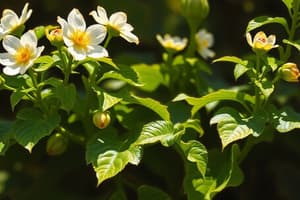Podcast
Questions and Answers
What is the main objective of the experiment discussed in this module?
What is the main objective of the experiment discussed in this module?
- To examine the pigments extracted from Moringa oleifera leaves and their separation (correct)
- To compare the pigments found in Moringa oleifera leaves with other leaf types
- To analyze the chemical composition of malunggay leaves
- To identify the most common pigment found in Moringa oleifera leaves
What is the local name of the Moringa oleifera leaves used in this experiment?
What is the local name of the Moringa oleifera leaves used in this experiment?
- Bawang
- Pechay
- Malunggay (correct)
- Kangkong
What is the primary purpose of using an Erlenmeyer flask in this procedure?
What is the primary purpose of using an Erlenmeyer flask in this procedure?
- To contain the powder and acetone mixture during swirling (correct)
- To filter the powder from the acetone solution
- To mix the powder with acetone
- To heat the powder at a high temperature
What is the likely reason for decanting the dark green solution into an evaporating dish?
What is the likely reason for decanting the dark green solution into an evaporating dish?
What is the purpose of swirling the mixture in the Erlenmeyer flask?
What is the purpose of swirling the mixture in the Erlenmeyer flask?
What is the likely color of the initial powder?
What is the likely color of the initial powder?
What is the primary function of the iron stand in the given experiment?
What is the primary function of the iron stand in the given experiment?
What is the role of acetone in this procedure?
What is the role of acetone in this procedure?
What is the recommended thickness of the sand layer in the column?
What is the recommended thickness of the sand layer in the column?
What is the purpose of using sand in the column?
What is the purpose of using sand in the column?
What would be the consequence of using a thicker layer of sand than recommended?
What would be the consequence of using a thicker layer of sand than recommended?
What would happen if the pipette was not clamped to the iron stand?
What would happen if the pipette was not clamped to the iron stand?
What is the primary concern when handling a TLC plate?
What is the primary concern when handling a TLC plate?
What could be the consequence of impurities and skin oil on a TLC plate?
What could be the consequence of impurities and skin oil on a TLC plate?
Why is it recommended to only touch the margins of a TLC plate?
Why is it recommended to only touch the margins of a TLC plate?
What type of results can be expected if a TLC plate is contaminated with impurities and skin oil?
What type of results can be expected if a TLC plate is contaminated with impurities and skin oil?
Why is careful handling of a TLC plate important?
Why is careful handling of a TLC plate important?
What is the primary advantage of using an organic photovoltaic integrator with three complementary absorption bands?
What is the primary advantage of using an organic photovoltaic integrator with three complementary absorption bands?
What is the likely result of using a photovoltaic integrator with only one absorption band?
What is the likely result of using a photovoltaic integrator with only one absorption band?
What is the primary characteristic of an organic photovoltaic integrator?
What is the primary characteristic of an organic photovoltaic integrator?
What is the likely benefit of enhancing the efficiency of organic photovoltaic integrators?
What is the likely benefit of enhancing the efficiency of organic photovoltaic integrators?
What is the significance of three complementary absorption bands in an organic photovoltaic integrator?
What is the significance of three complementary absorption bands in an organic photovoltaic integrator?




